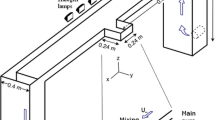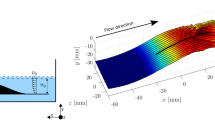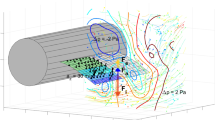Abstract
Optical refraction at interfaces is a common issue when viewing a submerged specimen through a transparent window. The distortions that are introduced during such imaging must be minimized when employing stereo-vision systems to make accurate quantitative (a) position, displacement, velocity and strain measurements on structures immersed in fluids via marker tracking and (b) velocity measurements along particle paths in a fluid via particle tracking. In this study, for the first time an optical model with refraction at multiple media interfaces that was developed previously for stereo-vision based measurements in fluids is experimentally validated via (a) motion and strain measurements on an immersed, rotating surface and (b) particle tracking in a fluid. Consistent with the model, the calibration and reconstruction processes are developed and demonstrated experimentally to be effective in removing distortions. To demonstrate the utility of the method for accurate measurements on submerged objects, the authors measured positions and strains on a rotating, rigid surface through stereo-imaging of specific features. Results confirmed that the vision-based method is accurate and repeatable for measuring 3D positions and strains on submerged bodies. The methodology is then applied to the study of extrusion processes. Using a transparent small scale lab model extruder with a highly viscous fluid designed for use with stereo vision measurement systems, the 3D motions of neutrally buoyant spherical particles are measured during the extrusion process and compared to CFD simulation predictions. Results confirm that the dual calibration-stereo imaging approach is more accurate and effective for particle tracking than typical approaches used in such studies.


















Similar content being viewed by others
Notes
The marker tracking option in the code VIC-3D, www.correlatedsolutions.com, is used to obtain the 3D positions. Due to the relatively small size of the sugar particles used in the experiments (less than 7×7 pixels) and the relatively large displacements between images, initial particle position estimates at many/most time steps are required to be input manually.
For wire extrusion using aluminum chips with (density ρ = 2700 kg/m3), a typical die rotation rate N = 250 rpm, a chamber diameter of D = 25.4 mm (shown in Fig. 13) and an estimated extrudate viscosity range from μ = 105---107 Pa-s, an estimate for the range of Reynolds numbers is 2.28 ×10-6 < Re < 2.28 × 10–4, where the highest value for Re corresponds to the least viscous region (i.e., hottest region) in the material.
References
Peters WH, Ranson WF (1981) Digital imaging techniques in experimental stress analysis. Opt Eng 21:427–431
Sutton MA, Wolters WJ, Peters WH, Ranson WF, McNeill SR (1983) Determination of displacements using an improved digital correlation method. Image Vis Comput 1(3):133–139
Chu WF, Ranson WF, Sutton MA (1985) Applications of digital-image-correlation techniques to experimental mechanics. Exp Mech 25(3):232–244
Bruck HA, McNeil SR, Sutton MA, Peters WH (1989) Digital image correlation using Newton–Raphson method of partial differential correction. Exp Mech 29(3):261–267
Luo PF, Chao YJ, Sutton MA, Peters WH III (1993) Accurate measurement of three-dimensional deformations in deformable and rigid bodies using computer vision. Exp Mech 33:123–133
Helm JD, McNeil SR, Sutton MA (1996) Improved 3D image correlation for surface displacement measurement. Opt Eng 35:1911–1920
Sutton MA, Tiwari V, Zhao X, Deng X, Fourney W, Leiste U, Bretall D (2010) Full-field deformation measurements under explosive loading conditions using multi-image pattern analysis. Int J of Blasting and Fragm 4(3):193–206
Zhao X, Tiwari V, Sutton MA, Deng X, Fourney W, Leiste U (2013) Scaling of the deformation histories for clamped circular plates subjected to buried charges. Int J of Impact Eng 54:31–50
Zhao X, Hurley R, Sutton MA, Fourney W, Leiste U, Deng X (2013) Small scaled models subjected to buried blast loading part I: floorboard accelerations and related passenger injury metrics with protective hulls. Exp Mech doi:. doi:10.1007/s11340-013-9834-2
Adrian RJ, Westerweel J (2011) Particle image velocimetry. Cambridge University Press, New York
Rossi M, Cierpka C, Segura R, Kähler CJ (2011) Volumetric reconstruction of the 3D boundary of stream tubes with general topology using tracer particles. Meas Sci Technol 22(10):1–13. doi:10.1088/0957-0233/22/10/105405
Sutton MA, McFadden C (2000) Development of a methodology for non-contacting strain measurements in fluid environments using computer vision. Opt and Laser in Eng 32:367–377
Hobson PR, Watson J (1999) Accurate three-dimensional metrology of underwater objects using replayed real images from in-line and off-axis holograms. Meas Sci Technol 10:1153–1161
Moore KD (2001) Intercalibration method for underwater three-dimensional mapping laser line scan systems. Appl Opt 40(33):5991–6004
Plakas K, Trucco E, Fusiello A (1998) Uncalibrated vision for 3D underwater applications. Oceans’ 98 Conf Proc 28(1):272–276
Kwon YH (1999) Object plane deformation due to refraction in two-dimensional underwater motion analysis. J Appl Biomech 15:396–403
Taboada B, Larralde P, Brito-Albavera T, Vega L, Diaz R, Galindo E, Corkidi G (2003) Images acquisition of multiphase dispersion in fermentation processes. J of Appl Res and Tech 1:78–84
Corkidi G, Voinson T, Taboada BI, Cordova MS, Galindo E (2008) Accurate determination of embedded particles within dispersed elements in multiphase dispersions, using a 3D micro-stereoscopic vision system. Chem Eng Sci 63:317–329
Kyme A, Meikle S, Baldock C, Fulton R (2012) Refraction-compensated motion tracking of unrestrained small animals in positron emission tomography. Med Image Anal 16:1317–1328
Ke X, Sutton MA, Lessner S, Schreier HW (2008) Robust stereovision and calibration methodology for accurate 3D digital image correlation measurements on submerged objects. J Strain Anal Eng Des 43:689–704
Tropea C, Yarin A, Foss J (2007) Handbook of experimental fluid mechanics. Springer, Berlin
Durst F, Melling A, Whitelaw JH (1976) Principles and practice of laser-Doppler anemometry. Academic, London
Adrian RJ (1991) Particle imaging techniques for experimental fluid-mechanics. Annu Rev Fluid Mech 23:261–304
Raffel M, Willert C, Werely S, Kompenhans J (2007) Particle image velocimetry: a practical guide. Springer, Berlin
Hu H, Saga T, Kobatashi T, Taniguchi N, Yasuki M (2001) Dual-plane stereoscopic particle image velocimetry: system set-up and its application on a lobed jet mixing flow. Exp Fluids 31:277–293
Ganapathisubramani B, Longmire EK, Marusic I, Pothos S (2005) Dual-plane PIV technique to determine the complete velocity gradient tensor in a turbulent boundary layer. Exp Fluids 39:222–231
Kähler CJ, Kompenhans J (2000) Fundamentals of multiple plane stereo particle image velocimetry. Exp. Fluids Suppl. S70-S77
Gaydon M, Raffel M, Willert C, Rosengarten M, Kompenhans J (1997) Hybrid stereoscopic particle image velocimetry. Exp Fluids 23(4):331–334
Ak P, Adrian RJ (1993) Stereoscopic particle image velocimetry applied to liquid flows. Exp Fluids 15:49–60
Larmore L (1965) Introduction to photographic principles. Dover, New York
Lai GJ, Shen GX (2012) Experimental investigation on the wing –wake interaction at the mid stroke in hovering flight of dragonfly. Sci China Phys Mech Astron 55:2167–2178
Soloff SM, Adrian RJ, Liu ZC (1997) Distortion compensation for generalized stereoscopic particle imaging velocoimetry. Meas of Sci and Technol 8:1441–1454
Raffel M, Kost F (1998) Investigation of aerodynamic effects of coolant ejection at the trailing edge of a turbine blade model by PIV and pressure measurements. Exp Fluids 24:447–461
Johnston W, Dybbs A, Edwards R (1975) Measurement of fluid velocimetry inside porous media with a laser anemometer. Phys Fluids 18(7):913–914
Hopkins LM, Kelly JT, Wexler AS (2000) Particle image velocimetry measurement in complex geometries. Exp Fluids 29:91–95
Budwig R (2004) Refraction index matching methods for liquid flow investigations. Exp Fluid 17:350–355
Arizaga R, Cap N, Rabal H, Trivi M (2010) Image distortion due to refraction by planar surfaces. Eur J Phys 31:115–127
Bao XL, Li MG (2011) Defocus and binocular vision based stereo particle pairing method for 3D particle tracking velocimetry. Optics and Laser in Eng 19:623–631
Kähler CJ, Scharnowski S, Cierpka C (2012) On the resolution limit of digital particle image velocimetry. Exp Fluids 52:1629–1639
Werner MP (2000) Development of digital particle imaging velocimetry for use in turbomachinery. Exp Fluids 28:97–115
Gan L, Nickels TB, Dawson JR (2011) An experimental study of a turbulent vortex ring: a three-dimensional representation. Exp Fluids 51:1493–1507. doi:10.1007/s00348-011-1156-5
Worth N, Nickels T, Swaminathan NA (2010) Tomographic PIV resolution study based on homogeneous isotropic turbulence DNS data. Exp Fluids 49:637–656
Elsinga GE, Scarano F, Wieneke B, van Oudheusden BW (2006) Tomographic particle image velocimetry. Exp Fluids 41:933–947. doi:10.1007/s00348-006-0212-z
Atkinson C, Coudert S, Foucaut JM, Stanislas M, Soria J (2011) The accuracy of tomographic particle image velocimetry for measurements of a turbulent boundary layer. Exp Fluids 50(4):1031–1056
Elsinga GE, Westerweel J, Scarano F, Novara M (2011) On the velocity of ghost particles and the bias errors in tomographic-PIV. Exp Fluids 50(4):825–838
Gao Q, Wang HP, Shen GX (2013) Review on development of volumetric particle image velocimetry. Fluid Mech 58(36):4541–4556
Maas HG, Gruen A, Papantomiou D (1993) Particle tracking velocimetry in three-dimensional flows. Part I. Exp Fluid 15:133–146
Malik NA, Dracos T, Papantomiou D (1993) Particle tracking velocimetry in three-dimensional flows Part II. Exp Fluid 15:279–297
Hain R, Kähler CJ, Tropea C (2007) Comparison of CCD CMOS and intensified cameras. Exp Fluids 42(3):403–411
Michaelis D, Novara M, Scarano F, Wieneke B (2010) Comparison of volume reconstruction techniques at different particle densities,15th Int Symp on Applications of Laser Techniques to Fluid Mechanics Lisbon, Portugal
Kim D, Gharib M (2010) Experimental study of three-dimensional vortex structures in translating and rotating plates. Exp Fluids 49:329–339. doi:10.1007/s00348-010-0872-6
Cheng B, Sane SP, Barbera G, Troolin DR, Strand T, Deng XY (2013) Three-dimensional flow visualization and vorticity dynamics in revolving wings. Exp Fluids 54:1423. doi:10.1007/s00348-012-1423-0
Timpe A, Zhang Z, Hubner J, Ukeiley L (2013) Passive flow control by membrane wings for aerodynamic benefit. Exp Fluids 54(3):1471. doi:10.1007/s00348-013-1471-0
Zhang Z, Hubner JP, Timpe A, Ukeiley L, Abudarm Y, Ifju P 92012) Effect of aspect ratio on flat-plate membrane airfoils. January, Nashville, AIAA-2012-1084
Zhang Z, Martin N, Wrist A, Hubner JP, Abudaram Y, Ukeiley L, Ifju PG (2013) Force and deformation measurement of low aspect ratio membrane airfoils. AIAA Paper 2013–0682, 51th Aerospace Sciences Meeting and Exhibit, Grapevine, Texas, 07–10
Wolf E, Kahler CJ, Troolin DR, Kykal C, Lai W (2011) Time-resolved volumetric particle tracking velocimetry of large-scale vortex structures from the reattachment region of a laminar separation bubble to the wake. Exp Fluids 50:977–988
Tang HW, Chen C, Huang JT (2008) An improved PTV system for large-scale physical river model. J Hydrodyn 20(6):669–678
Coz JL, Hauet A, Pierrefeu G, Dramais G, Camenen B (2010) Performance of image-based velocimetry (LSPIV) applied to flash-flood discharge measurements in Mediterranean river. J Hydrol 394(1–2):42–52
Dramais G, Coz JL, Camenen B, Hauet A (2011) Advantages of a mobile LSPIV method for measuring flood discharges and improving stage-discharge curves. J Hydro Environ Res 5(4):301–312
Kantoush SA, Anton JS, Tetsuya S, Murasaki M (2011) LSPIV implementation for environmental flow in various laboratory and field cases. J Hydro Environ Res 5(4):263–276
Muste M, Ho H-C, Kim D (2011) Considerations on direct stream flow measurements using video imagery: outlook and research needs. J Hydro Environ Res 5(4):289–300
Muste M, Xiong Z, Schone J, Li Z (2004) Flow diagnostic in hydraulic modeling using image velocimetry. J Hydraul Eng 130(3):175–185
Li DX, Zhong Q, Yu MZ, Wang XK (2008) Large-scale particle tracking velocimetry with multi-channel CCD cameras. Int J of Sediment Res 28:103–110
Lobutova E, Resagk C, Putze T (2010) Investigation of large-scale circulations in room air flows using three-dimensional particle tracking velocimetry. Build Environ 45:1653–1662
Fujita I, Muste M, Kruger A (1998) Large-scale particle image velocimetry for flow analysis in hydraulic engineering applications. J Hydraul Res 36(3):397–414
Kim H, Lee S (2002) Performance improvement of two-frame particle tracking velocimetry using a hybrid adaptive scheme. Meas Sci Technol 13(4):519–534
Kim Y (2006) Uncertainty analysis for non-intrusive measurement of river discharge using image velocimetry. Ph.D. Thesis University of Iowa, Iowa, United States
Kim KC (2012) Advances and applications on micro-defocusing digital particle image velocimetry (μ-DDPIV) techniques for microfluidics. J Mech Sci Technol 26(12):3769–3784
Yoon SY, Kim KC (2006) 3D particle position and 3D velocity field measurement in a microvolume via the defocusing concept. Meas Sci Technol 17:2897–2905
Pereira F, Lu J, Castaňo-Graff E, Gharib M (2007) Microscale 3D flow mapping with lDDPIV. Exp Fluids 42:589–599
Cierpka C, Kähler CJ (2012) Particle image techniques for volumetric three-component (3D3C) velocity measurements in microfluidics. J Vis 15:1–31
Sbalzarini IF, Koumoutsakos P (2005) Feature point tracking and trajectory analysis for video imaging in cell biology. J Struct Biol 151:182–195
Valentine MT, Perlman ZE, Gardel ML, Shin JH, Matsudaira P, Mitchison TJ, Weitz DA (2004) Colloid surface chemistry critically affects multiple particle tracking measurements of biomaterials. Biophys J 86(6):4004–4014
Babcock HP, Chen C, Zhuang XW (2004) Using single-particle tracking to study nuclear trafficking of viral genes. Biophys J 87(4):2749–2758
Kang H, Ahn KH, Lee SJ (2010) Rheological properties of dilute polymer solutions determined by particle tracking microrheology and bulk rheometry. Korea-Australia Rheol Journal 22(1):11–19
Moschakis T (2013) Microrheology and particle tracking in food gels and emulsions. Colloid & Interface Sci 18:311–323
Bonales LJ, Ritacco H, Rubio JEF, Rubio RG, Monroy F, Ortega F (2007) Dynamics in ultrathin films: particle tracking microrheology of langmuir monolayers. The Open Phys Chem J 1:25–32
Holenberg Y, Lavrenteva OM, Shavit U, Nir A (2012) Particle tracking velocimetry and particle image velocimetry study of the slow motion of rough and smooth solid spheres in a yield-stress fluid. Phys rev E 86:066301
Wang Y, Ning J, Johnson JA, Sutton MA, Lessner SM (2011) Development of a quantitative mechanical test of atherosclerotic plaque stability. J Biomech 44(13):2439–2445
Ning J, Braxton VG, Wang Y, Sutton MA, Wang YQ, Lessner SM (2010) Speckle patterning of soft tissues for strain field measurement using digital image correlation: preliminary quality assessment of patterns. Microsc Microanal 17(1):81–90
Ning J, Xu S, Wang Y, Lessner SM, Sutton MA, Anderson K, Bischoff JE (2010) Deformation measurements and material property estimation of mouse carotid artery using a microstructure-based constitutive model. J Biomech Eng 132(12):121010
Wang Y, Ning JF, Sutton MA, Lessner SM (2010) Development of a quantitative mechanical test of atherosclerotic plaque stability. Proceedings of the ASME 2010 Summer Bioengineering Conference, Podium session 20-2-3, Abstract No. 19489, Naples, FL
Guo SM, Sutton MA, Li XD, Li N, Wang LW (2013) SEM-DIC based nanoscale thermal deformation studies of heterogeneous material. Proceeding of SEM 2013 Annual Conference
Thomas WM, Nicholas ED, Jones SB (1993) US Patent # 5,262,123
Tang W, Reynolds AP (2010) Production of wire via friction extrusion of aluminum alloy machining chips. J Mater Process Tech 210:2231–2237
Crowe C, Schwarzkopf J, Sommerfeld M, Tsuji Y (2012) Multiphase flows with droplets and particles (second edition). CRC Press, Boca Raton
Cundall PA, Strack ODL (1979) A discrete numerical model for granular assemblies. Geotechnique 29:47–65
Xu M, Chen F, Liu X, Ge W, Li J (2012) Discrete particle simulation of gas–solid two-phase flows with multi-scale CPU–GPU hybrid computation. Chem Eng J 207–208:746–757
Kawaguchi T, Tanaka T, Tsuji Y (1998) Numerical simulation of two-dimensional fluidized beds using the discrete element method (comparison between the two- and three-dimensional models). Powder Technol 96:129–138
ANSYS Inc., (2010) ANSYS FLUENT theory guide (release 13.0), SAS IP Inc
Morsi SA, Alexander AJ (1972) An investigation of particle trajectories in two-phase flow systems. J Fluid Mech 55:193–208
http://www.geology.um.maine.edu/,Ultra high pressure metamorphic terrance development an analog modeling study, Charles Rodda, Department of Earth Science, University of Maine
Zhang H., Zhao X., Deng X., Sutton M.A., Reynolds A.P., McNeil S.R., Ke K. (2014) Investigation of material flow during friction extrusion process. Int. J. of Mechanical Science (accepted)
Acknowledgments
The financial support provided by NASA Consortium Agreement NNX10AN36A and by the National Science Foundation through NSF-CMMI-1266043 is gratefully acknowledged. The financial support of the Department of Mechanical Engineering at the University of South Carolina through TA offerings is also deeply appreciated. The technical support provided by Mr. Daniel Wilhelm and Dr. Wei Tang in this effort is also gratefully acknowledged.
Author information
Authors and Affiliations
Corresponding author
Rights and permissions
About this article
Cite this article
Zhao, X., Sutton, M.A., Zhang, H. et al. Stereo Image Based Motion Measurements in Fluids: Experimental Validation and Application in Friction Extrusion. Exp Mech 55, 177–200 (2015). https://doi.org/10.1007/s11340-014-9907-x
Received:
Accepted:
Published:
Issue Date:
DOI: https://doi.org/10.1007/s11340-014-9907-x




